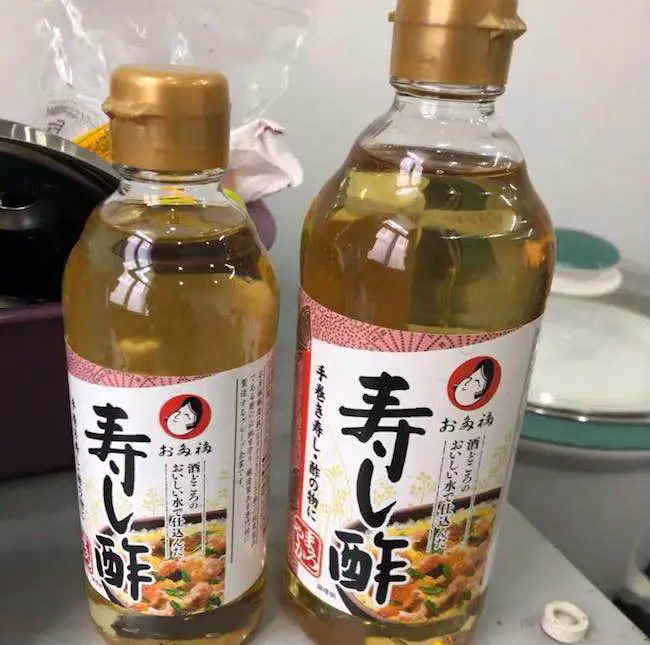We are reader supported. When you purchase through links on our site, we may earn an affiliate commission. Also, as an Amazon affiliate, we earn from qualifying purchases.

My stay in Japan has made me a fan of Japanese cuisine and I have learned to value the importance of traditional ingredients that lend the right taste and aroma. I am often amused when I see my western friends confuse rice vinegar with sushi vinegar or use cooked crabmeat instead of raw fish in sushi.
A friend once asked me ‘Can I use sushi vinegar instead of rice vinegar?’ Well, here is the answer. Sushi vinegar (both instant powder and liquid mixes) are good substitutes for rice vinegar. It is the quick and ready-to-use solution for making sushi rice.
When using rice vinegar, while you will need to add sugar and salt to enhance the flavor before adding it to cooked rice. However, you may directly add sushi vinegar to cooked rice to have seasoned rice ready to make home grade sushi.
While the instant powder sushi vinegar works best for the busy bees, try out the liquid instant sushi mixes if you would like something more delicious. But, before that let’s take a look at rice vinegar and how it originated.
Contents
What Is Rice Vinegar
Rice vinegar is one of the main ingredients used in sushi to season sushi rice and make it ready for the final step. The genuine rice vinegar used in Japan is about 4% acidic, which is less than several fruit-based vinegar such as persimmon, plum, tart, and cherry.
Texture-wise, the rice vinegar is mild and mellow, and the color may range from colorless to pale yellow. This vinegar is usually made from fermenting rice or sake lees. In Japan, they are widely used in making sushi and a variety of other dishes such as tsukemono,
Seasoned rice vinegar, referred to as sushi vinegar, is made by adding salt, sugar, and sake to rice vinegar. It is often used as a substitute for rice vinegar. Sushi bars in western countries also use different variations of rice vinegar as substitutes to make modify sushi to appeal the westerners.
Related Article: Can you make Sushi without Rice Vinegar?
Difference Between Sushi Vinegar And Rice Vinegar
If you find sushi vinegar and rice vinegar confusing, here’s a formula by a sushi expert. Just remember this formula and you will never again be confused about these two:
Sushi Vinegar = Rice Vinegar + Salt + Sugar
When you are looking to flavor sushi rice quickly without having to worry about how much salt or sugar to put into it, I would suggest that you use sushi vinegar. If you use plain rice vinegar, your sushi will be tasteless because vinegar gets its seasoning from sugar and salt.
If you are looking for ‘pre-mixed sushi seasoning’ to take the guesswork out of mixing vinegar with sugar and salt, what you need to buy is the ‘sushi vinegar’. Brands like Mizkan usually sell both sushi vinegar and rice vinegar. Hence, you need to pay attention to the label.
Some people prefer buying rice vinegar instead of sushi vinegar so that they can enjoy the liberty of seasoning the vinegar as per their taste. The downside of buying pre-mixed sushi seasoning or sushi vinegar is that you cannot make it less sweet or salty to match your preference.
Sushi connoisseurs prefer using rice vinegar and adding seasoning as per their choice to get a perfect ratio. For example, here is a sushi vinegar recipe by another popular chef:
• Rice Vinegar (60ml or 60g)
• Sugar (60g)
• Salt (10g)
This quantity is enough to season 300 grams of short-grained raw rice. The ratio is something like this – Rice Vinegar: Sugar: Salt – 6: 6: 1. You may change this ratio to suit your taste.
To make sushi vinegar, add all the three ingredients together and heat up the mixture until the solids dissolve completely. If you are making the sushi vinegar in advance, combine them and leave in a jar inside a cupboard to let the solids dissolve naturally.
Some sushi chefs also recommend adding Mirin (sweet sake) or a piece of Konbu (kelp) to enhance the flavor and taste of sushi vinegar.
How Much Sushi Vinegar Should Be Added To Cooked Rice
When making sushi rice to be used as filling in traditional sushi, it is essential to get the right ratio or you may end up making the sushi rice too sweet or lacking in taste. To get that perfect sushi bar flavor, I would recommend that you use about 20mls (or grams) of Sushi vinegar for 100g of raw short-grained rice.
So, that means you need approximately 20% of sushi vinegar in weight of the raw rice used. If you are using 500 grams of cooked rice, then you will need to add 100 mls or grams of sushi vinegar to season the rice properly.
How To Properly Season Rice With Sushi Vinegar

After the rice is cooked to a firm and non-sticky consistency, you can go ahead and season the rice when it is still hot. Use a wooden paddle to gently scoop out the rice into a big bowl. Avoid using a metal paddle as this may break the grains.
In Japan, people prefer using a wooden bowl for seasoning and the bowl is called ‘Oke’ or ‘Hangiri’ in Japanese. The specialty of Hangiri is that the wood helps in absorbing any excess amount of vinegar in the rice. If you do not have a wooden bowl, use a plastic bowl instead. Just make sure you use a large bowl with a flat base.
Avoid scraping out rice from the bottom of the rice cooker, as it may be crispy or burned, which is not ideal for sushi making. If the rice is stuck to the bottom, it is better to avoid it. Use only the perfectly cooked, soft, yet firm rice for making good sushi.
Next, you need to add sushi vinegar to rice to give it that sweet and sour taste. As mentioned above, sushi vinegar should be 20% of the amount of raw rice used. To add vinegar, don’t simply pour on top of it. Instead, use a wooden paddle to spread the vinegar evenly over the cooked rice to ensure that each grain is well-coated with the seasonings.
An important tip – you must add sushi vinegar to cooked rice and mix it well when the rice is still steaming hot. The heat helps in balancing the flavor and as the rice cools down, the‘vinegariness’ mellows down a bit giving you perfectly seasoned sushi rice that smells and tastes great.
What Other Substitutes Can Be Used For Rice Vinegar
White wine vinegar is often used as a popular substitute for rice vinegar. It is made by fermenting white wine into vinegar. It has a mild and slightly acidic taste. Its flavor is so similar to rice vinegar that it is often used as a substitute in salad dressings and sauces. You may add a little sugar to it and use for seasoning sushi rice.
Apple Cider Vinegar is another substitute made from fermented apple cider. This type of vinegar has a mild taste with a hint of apple that makes it taste great when added to marinades and sauces. You may add some sugar for sweetening and use apple cider vinegar to add flavor to sushi rice.
Champagne vinegar is made by fermenting champagne to make vinegar. It has a light and delicate flavor, quite similar to rice vinegar. It can be used in a variety of dishes without overpowering the taste. You may use champagne vinegar as a substitute if you have run out of sushi vinegar or rice vinegar.
Related Questions
Why is sugar added to rice vinegar before seasoning rice?
Sugar and salt are added to balance out the sour taste of vinegar and make the sushi rice sweet and delicious to taste. You can adjust the sweetness by adding a little or some extra sugar to rice vinegar as per your preference.
Why do the Japanese season rice with vinegar?
The tradition actually goes back to the time when sushi was originated. Sushi literally means ‘sour’ flavor. History has it that people in Japan wrapped fish in rice to save them from being spoiled in the past. So, the rice wrapped around fish fermented over a period.
Fermented rice was discarded and people enjoyed the fish. However, sometime around the 1500s, people started using vinegared rice to store fish to further increase the shelf life. Vinegar made the rice taste good and people enjoyed eating it with fish. The sushi you and I eat today is a modernized form of that old tradition.
How much sugar and salt should be added to rice vinegar?
To make 60 grams of sushi vinegar, you must add 60 grams of sugar and 10 grams of salt. So, the ratio should be 6:6:1 (vinegar: sugar: salt).
The Final Words
When making sushi at home, you will always need sushi vinegar to season the cooked rice and give it that delicious taste. However, it depends on you whether you want to use pre-seasoned sushi vinegar powered, liquid instant mix or make your own sushi vinegar using rice vinegar, sugar, and salt.
I prefer and recommend you to make your own sushi vinegar at home because not all brands taste alike. Some instant mixes may be too sweet than what you like. Making your own sushi vinegar is not only fun but it also gives you more control over the flavor. You may make your sushi rice sweeter or let it stay a bit sour, just as you like it!


Comments
Pingback: 7 Ways To Make Sushi Without Seaweed - Easy Homemade Sushi